In this exercise, the aim was to produce a series of drawings using different types of perspective. As someone who has mostly always relied on winging it when it comes to perspective, this was an interesting one to do.
I started by taking a photograph to work from for each viewpoint, so a one point for the living room, a two point at the bottom of the stairs and a three point of the landing.
The one point perspective image was fairly simple to produce here, using just a mechanical pencil, a putty eraser and a very large metal ruler, along with a standard plastic one for the small stuff.
Working from photographs, you can take certain liberties in finding the vanishing points just by drawing convergence lines on the longest edges. That gives you a decent starting point if you’re producing a 1:1 image (A4 photo to A4 drawing etc)
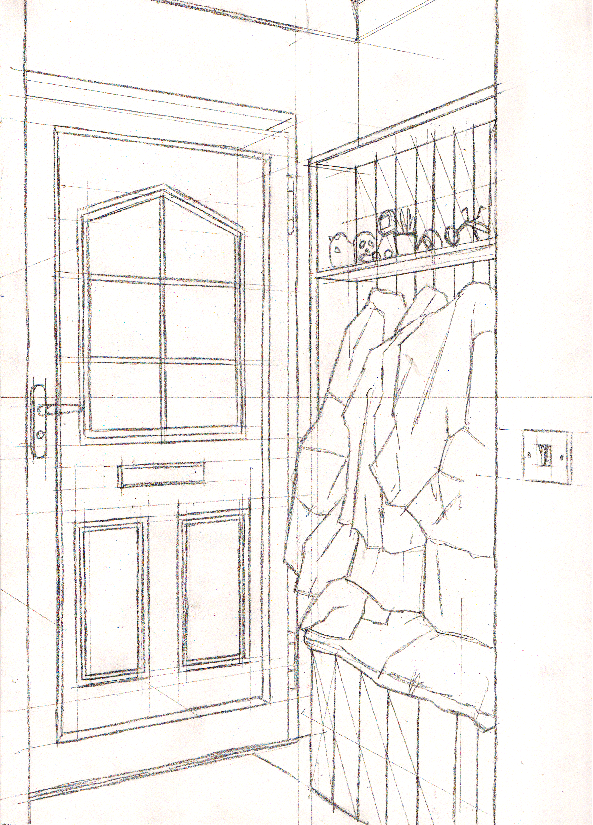
For the two point perspective drawing, I found I couldn’t get a decent enough viewpoint in the living room so I opted to create an image from the bottom of our staircase in the front doorway. Even though I have a reasonable sized drawing board, the vanishing points were quite far off on the right hand side. In this case, I opted to use the Brewer method where you can measure spaced points on one side of the image and use smaller spacing on the opposite side to recreate the vanishing point without actually having to rely on one which is an unrealistic distance from the drawing. In this image I also got to use the handy diagonal spacing trick for doing spatially correct verticals on the coat hanger.
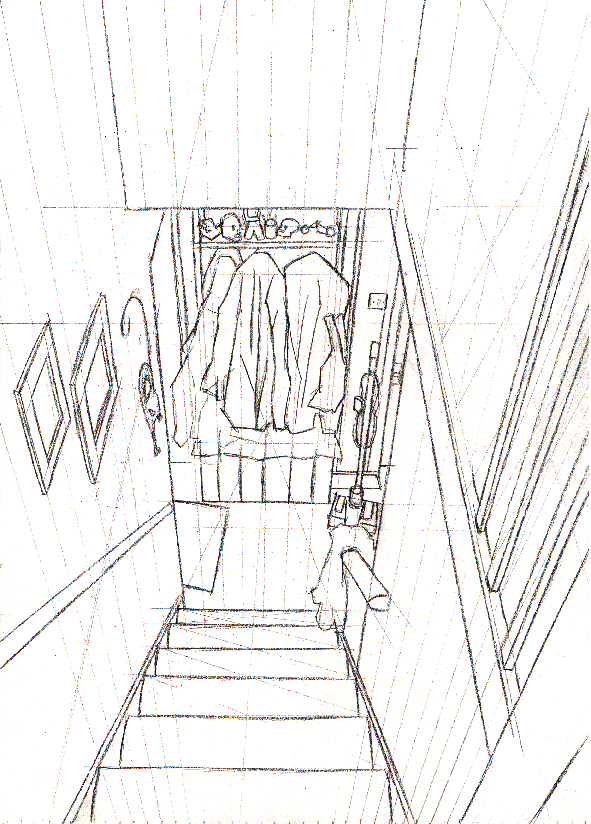
I chose this image for the 3 point perspective image, although technically I don`t think it actually does have 3 vanishing points : it was still a challenge though, as it has multiple vanishing points on different angle planes, such as the stairs. I messed up the railing spindles here due to some incorrect spacing on the Brewer method marking.
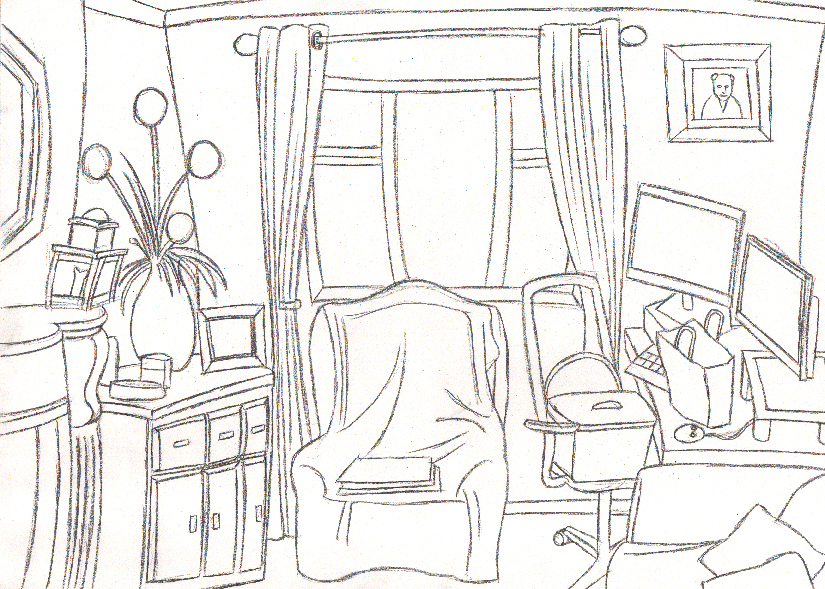
This attempt was the magical realism approach, where things were kind of intentionally off-kilter and the perspectives were flatter and made less accurate visual sense. I felt this had a somewhat impressionist or surreal feel to it, and it’s a type of representation I often return to for anything imagined with some degree of detachment. Forcing this type of perspective usually leaves the viewer in no doubt that they’re seeing something divorced from reality to some degree.
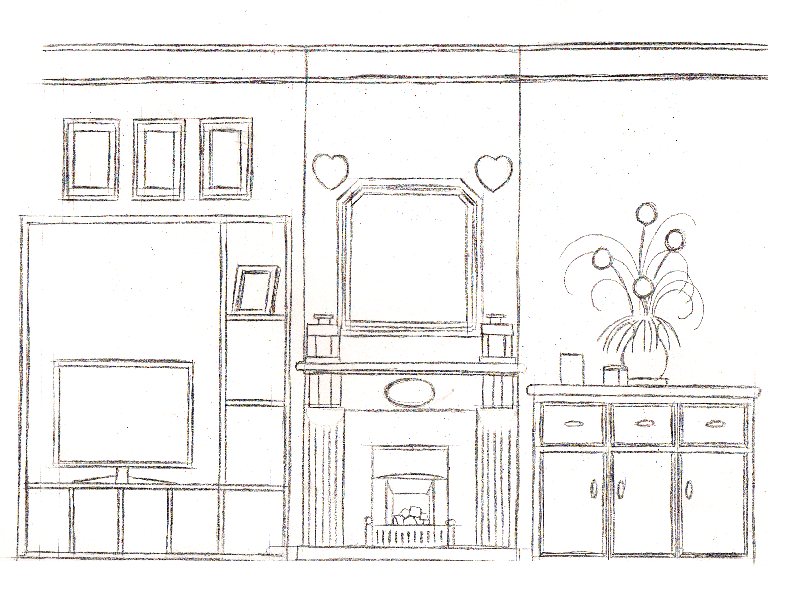
The flat representation. This was pretty straightforward, although in order to get this onto A4 I had to make a few adjustments to the horizontal aspect, which squashes everything into the width. I used a similar viewpoint for some of the experimental ideas in Illustration 1 : Holiday guides
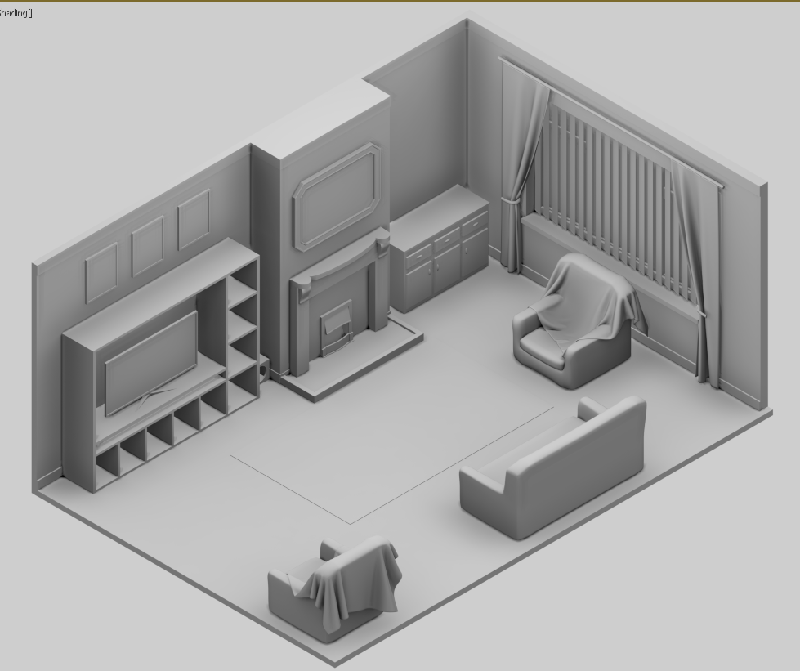
The Orthographic representation. I chose to employ a bit of a time saver here as I wasn’t too willing to do this without some degree of accuracy : for the sake of just completing this for the project I know I probably could have made it less representational, but as the other images were pretty accurate I chose to go with this.
The time saver in question was to 3D model the living room in 3D MAX. It’s a fairly simple scene anyway and the ability to set up an orthographic camera in seconds made it a cinch.
So firstly here, I set up the camera (target pointed to world zero and set to 45 degree angles X,Y & Z) then added the floor, walls, window, chimney breast, fire : all the major parts of the room. Then it was just a case of creating the furniture. The curtains and throws in the chairs were created using a cloth simulation.
This isn`t production rendered or anything fancy, it’s straight from the viewport with ambient occlusion applied and no shadows as they’d just interfere with the final thing. I can take this image into photoshop, print it out at A4 and use tracing paper to get a clean transfer of the image to use as a basis for the drawing.
This saves lots of time having to draw equally spaced isometric lines, then re-trace all from that to get the clean image etc.
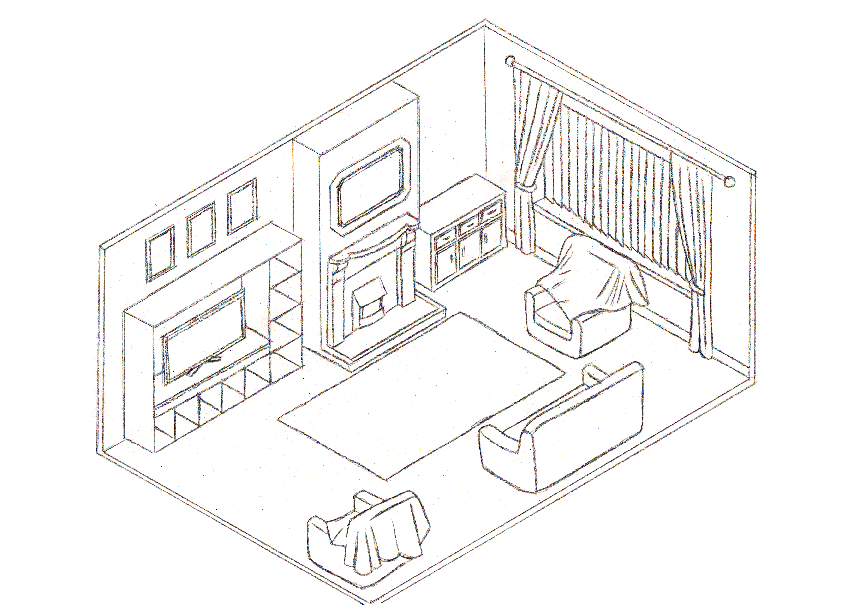
I know there’ll be a band of hard-core sadists who still draw isometric images by hand, I found it was probably one of the largest perspective styles to be embraced almost entirely digitally. I can remember RPG computer games using this perspective years ago, (many games today still use it) and i think technical illustrations such as assembly instruction manuals for IKEA furniture are even created in CAD programs these days. There’s a whole audience of pixel artists who create animated pieces in isometric views and it’s still as big as it ever was as a movement.
I can even recall creating isometric art for a Nokia mobile phone game many years ago in monochrome and the animated player character was created in 3D then animated on the spot in four directions. These were rendered out in 2D and movement was handled by the programmers.
The meaning of what’s being represented
starting with the one, two and three point perspectives, these are generally rooted more in expected reality as the brain readily accepts what it sees naturally every waking second in real time, even though 2D representations lack the expected depth : it’s good enough for us to see and know it’s representative with little questioning.
Conversely, if an image has been perceived as intentionally realistic and the perspective is off, this often acts as a trip-wire where the brain tries to reconcile what’s seen, but knows something is wrong.
The same phenomenon exists with representational anatomical studies where one or more proportions are off : a famous example might be Michelangelo’s David. Seen as it is low down at more of a ground level, there appear to be some scale anomalies (part of the genius here though is that the sculpture was intended to be viewed higher up, so the proportions were worked partly around this viewing aspect)
These perspective views offer much in terms of visual dynamics. A fast forward through just about any action, drama or horror movie will attest to the power of perspective to give a feeling of hopelessness, isolation, insignificance or vastness (birds eye view), a feeling of awe or naivety, or speed when combined with movement (worm’s eye view) : combine these with dutch angles and everything starts to become unsettling or jarring.
Comic and narrative art share these same tropes seamlessly, they’re practically the same except one is moving in real-time.
Magical realism perspective is often readily accepted due to the nature of the subject matter it’s being accompanied with. Imaginative illustration can capitalise on this lack of correct perspective when the subject is otherworldly, caricatured or imagined as there’s a visual willingness to accept that things aren’t as they should be in the real world.
Bending visual perspective rules this way becomes more relaxed the more detached or less representational the subject matter becomes, but that’s not to say artists don`t change these contexts all the time either!